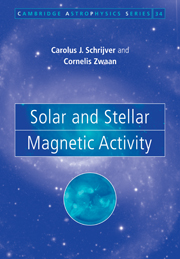Book contents
- Frontmatter
- Contents
- Preface
- 1 Introduction: solar features and terminology
- 2 Stellar structure
- 3 Solar differential rotation and meridional flow
- 4 Solar magnetic structure
- 5 Solar magnetic configurations
- 6 Global properties of the solar magnetic field
- 7 The solar dynamo
- 8 The solar outer atmosphere
- 9 Stellar outer atmospheres
- 10 Mechanisms of atmospheric heating
- 11 Activity and stellar properties
- 12 Stellar magnetic phenomena
- 13 Activity and rotation on evolutionary time scales
- 14 Activity in binary stars
- 15 Propositions on stellar dynamos
- Appendix I Unit conversions
- Bibliography
- Index
15 - Propositions on stellar dynamos
Published online by Cambridge University Press: 14 August 2009
- Frontmatter
- Contents
- Preface
- 1 Introduction: solar features and terminology
- 2 Stellar structure
- 3 Solar differential rotation and meridional flow
- 4 Solar magnetic structure
- 5 Solar magnetic configurations
- 6 Global properties of the solar magnetic field
- 7 The solar dynamo
- 8 The solar outer atmosphere
- 9 Stellar outer atmospheres
- 10 Mechanisms of atmospheric heating
- 11 Activity and stellar properties
- 12 Stellar magnetic phenomena
- 13 Activity and rotation on evolutionary time scales
- 14 Activity in binary stars
- 15 Propositions on stellar dynamos
- Appendix I Unit conversions
- Bibliography
- Index
Summary
In this final chapter we present a synopsis of the observational constraints on dynamo processes in stars with convective envelopes that complements our review of studies of the solar dynamo in Chapter 7. We do not try to summarize the rapidly growing literature on mathematical and numerical models of stellar dynamos, but rather we attempt to capture the observational constraints on dynamos in a set of propositions, following Schrijver (1996). You will encounter some speculative links that attempt to bring together different facets of empirical knowledge, but we shall always distinguish conclusions from hypotheses.
Throughout this book, we use the term dynamo in a comprehensive sense, implying the ensemble of processes leading to the existence of a magnetic field in stellar photospheres, which evolves on times scales that are very short compared to any of the time scales for stellar evolution or for large-scale resistive dissipation of magnetic fields. Such a dynamo involves the conversion of kinetic energy in convective flows into magnetic energy.
Solar magnetic activity is epitomized by the existence of small-scale (compared to the stellar surface area), long-lived (compared to the time scale of the convective motions in the photosphere), highly structured magnetic fields in the photosphere, associated with nonthermally heated regions in the outer atmosphere, in which the temperatures significantly exceed that of the photosphere. Other cool stars exhibit similar phenomena, which are collectively referred to as stellar magnetic activity.
- Type
- Chapter
- Information
- Solar and Stellar Magnetic Activity , pp. 344 - 350Publisher: Cambridge University PressPrint publication year: 2000



